Effect of Aeration Rates and Filter Media Heights on the Performance of Pollutant Removal in an Up-Flow Biological Aerated Filter
Abstract
:1. Introduction
2. Materials and Methods
2.1 Description of the Up-Flow BAF System
2.2 Inoculated Sludge and Synthetic Wastewater
2.3 Operation of The Up-Flow BAF
2.4 Chemical Analysis
2.5 Microbial Community Analysis
2.6 Statistical Analysis
3. Results and Discussion
3.1. Performance of UBAF Reactor
3.1.1. The Effect of Aeration Rates of COD Removal
3.1.2. The Effect of Aeration Rates of Nitrogen Removal
3.1.3. The Effect of Aeration Rates of Phosphorus Removal
3.2. Pollutants Removal at Different Filter Media Heights
3.2.1. The COD Removal at Different Filter Media Heights
3.2.2. The Nitrogen Removal at Different Filter Media Heights
3.2.3 The Phosphorus Removal at Different Filter Media Heights
3.3. Diversity and Evenness of the Microbial Community
3.4. Comparative Analysis of Microbial Community
3.4.1. The Effect of Aeration Rates on Microbial Community
3.4.2. The Effect of Filter Media Heights on Microbial Community
4. Conclusions
Author Contributions
Funding
Acknowledgments
Conflicts of Interest
References
- Yu, Q.; Huang, H.; Ren, H.; Ding, L.; Geng, J. In situ activity recovery of aging biofilm in biological aerated filter: Surfactants treatment and mechanisms study. Bioresour. Technol. 2016, 219, 403–410. [Google Scholar] [CrossRef] [PubMed]
- Liu, T.; Quan, X.; Li, D. Evaluations of biofilm thickness and dissolved oxygen on single stage anammox process in an up-flow biological aerated filter. Biochem. Eng. J. 2017, 119, 20–26. [Google Scholar] [CrossRef]
- Abu Hasan, H.; Sheikh Abdullah, S.R.; Tan Kofli, N.; Kamarudin, S.K. Effective microbes for simultaneous bio-oxidation of ammonia and manganese in biological aerated filter system. Bioresour. Technol. 2012, 124, 355–363. [Google Scholar] [CrossRef] [PubMed]
- Pramanik, B.K.; Fatihah, S.; Shahrom, Z.; Ahmed, E. Biological aerated filters (BAFs) for carbon and nitrogen removal: A review. J. Eng. Sci. Technol. 2012, 7, 428–446. [Google Scholar]
- Chen, T.; Peng, T.; Feng, C.; Chen, N.; Hu, Q.; Hao, C. The feasibility of an up-flow partially aerated biological filter (U-PABF) for nitrogen and COD removal from domestic wastewater. Bioresour. Technol. 2016, 218, 307–317. [Google Scholar] [CrossRef]
- Qiu, Y.; Zhang, C.; Li, B.; Li, J.; Zhang, X.; Liu, Y.; Liang, P.; Huang, X. Optimal Surface Aeration Control in Full-Scale Oxidation Ditches through Energy Consumption Analysis. Water 2018, 10, 945. [Google Scholar] [CrossRef]
- Wu, G.; Zheng, D.; Xing, L. Nitritation and N2O Emission in a Denitrification and Nitrification Two-Sludge System Treating High Ammonium Containing Wastewater. Water 2014, 6, 2978–2992. [Google Scholar] [CrossRef]
- Albuquerque, A.; Makinia, J.; Pagilla, K. Impact of aeration conditions on the removal of low concentrations of nitrogen in a tertiary partially aerated biological filter. Ecol. Eng. 2012, 44, 44–52. [Google Scholar] [CrossRef] [Green Version]
- Abu Hasan, H.; Sheikh Abdullah, S.R.; Kamarudin, S.K.; Tan Kofli, N.; Anuar, N. Simultaneous NH4+-N and Mn2+ removal from drinking water using a biological aerated filter system: Effects of different aeration rates. Sep. Purif. Technol. 2013, 118, 547–556. [Google Scholar] [CrossRef]
- Zou, Y.; Zhang, L.; Wang, L.; Zhang, S.; Yu, X. Effects of Aeration, Vegetation, and Iron Input on Total P Removal in a Lacustrine Wetland Receiving Agricultural Drainage. Water 2018, 10, 61. [Google Scholar] [CrossRef]
- Yang, K.; Yue, Q.; Kong, J.; Zhao, P.; Gao, Y.; Fu, K.; Gao, B. Microbial diversity in combined UAF-UBAF system with novel sludge and coal cinder ceramic fillers for tetracycline wastewater treatment. Chem. Eng. J. 2016, 285, 319–330. [Google Scholar] [CrossRef]
- Wang, H.; Dong, W.; Li, T.; Liu, T. Enhanced synergistic denitrification and chemical precipitation in a modified BAF process by using Fe2+. Bioresour. Technol. 2014, 151, 258–264. [Google Scholar] [CrossRef] [PubMed]
- Wu, C.Y.; Zhou, Y.X.; Wang, Y.; Guo, M.K. Innovative combination of Fe2+-BAF and ozonation for enhancing phosphorus and organic micropollutants removal treating petrochemical secondary effluent. J. Hazard. Mater. 2017, 323, 654–662. [Google Scholar] [CrossRef] [PubMed]
- Zhang, M.; Yang, Q.; Zhang, J.; Wang, C.; Wang, S.; Peng, Y. Enhancement of denitrifying phosphorus removal and microbial community of long-term operation in an anaerobic anoxic oxice-biological contact oxidation. J. Biosci. Bioeng. 2016, 122, 456–466. [Google Scholar] [CrossRef] [PubMed]
- Fish, K.; Osbornc, A.M.; Boxall, J.B. Biofilm structures (EPS and bacterial communities) in drinking water distribution systems are conditioned by hydraulics and influence discolouration. Sci. Total Environ. 2017, 593–594, 571–580. [Google Scholar] [CrossRef] [PubMed]
- Isanta, E.; Bezerra, T.; Fernández, I.; Suárez-Ojeda, M.E.; Pérez, J.; Carrera, J. Microbial community shifts on an anammox reactor after a temperature shock using 454-pyrosequencing analysis. Bioresour. Technol. 2015, 181, 207–213. [Google Scholar] [CrossRef] [PubMed] [Green Version]
- Zhang, Z.; Wang, Y.; Leslie, G.L.; Waite, T.D. Effect of ferric and ferrous iron addition on phosphorus removal and fouling in submerged membrane bioreactors. Water Res. 2015, 69, 210–222. [Google Scholar] [CrossRef] [PubMed]
- Bao, T.; Chen, T.; Tan, J.; Wille, M.L.; Zhu, D.; Chen, D.; Xi, Y. Synthesis and performance of iron oxide-based porous ceramsite in a biological aerated filter for the simultaneous removal of nitrogen and phosphorus from domestic wastewater. Sep. Purif. Technol. 2016, 167, 154–162. [Google Scholar] [CrossRef]
- Wang, X.; Han, J.; Chen, Z.; Jian, L.; Gu, X.; Lin, C.J. Combined processes of two-stage Fenton-biological anaerobic filter–biological aerated filter for advanced treatment of landfill leachate. Waste Manag. 2012, 32, 2401–2405. [Google Scholar] [CrossRef] [PubMed]
- Zhao, C.; Xie, H.; Xu, J.; Xu, X.; Zhang, J.; Hu, Z.; Liu, C.; Liang, S.; Wang, Q.; Wang, J. Bacterial community variation and microbial mechanism of triclosan (TCS) removal by constructed wetlands with different types of plants. Sci. Total Environ. 2015, 505, 633–639. [Google Scholar] [CrossRef] [PubMed]
- Wang, J.; Wang, Y.; Bai, J.; Liu, Z.; Song, X.; Yan, D.; Abiyu, A.; Zhao, Z.; Yan, D. High efficiency of inorganic nitrogen removal by integrating biofilm-electrode with constructed wetland: Autotrophic denitrifying bacteria analysis. Bioresour. Technol. 2017, 227, 7–14. [Google Scholar] [CrossRef] [PubMed]
- Mulder, A.; van de Graaf, A.A.; Robertson, L.A.; Kuenen, J.G. Anaerobic ammonium oxidation discovered in a denitrifying fluidized bed reactor. FEMS Microbiol. Ecol. 1995, 16, 177–183. [Google Scholar] [CrossRef]
- Pereira, A.D.; Leal, C.D.; Dias, M.F.; Etchebehere, C.; Chernicharo, C.A.L.; De Araújo, J.C. Effect of phenol on the nitrogen removal performance and microbial community structure and composition of an anammox reactor. Bioresour. Technol. 2014, 166, 103–111. [Google Scholar] [CrossRef] [PubMed]
- Chakravarthy, S.S.; Pande, S.; Kapoor, A.; Nerurkar, A.S. Comparison of denitrification between paracoccus sp. and diaphorobacter sp. Appl. Biochem. Biotechnol. 2011, 165, 260–269. [Google Scholar] [CrossRef]


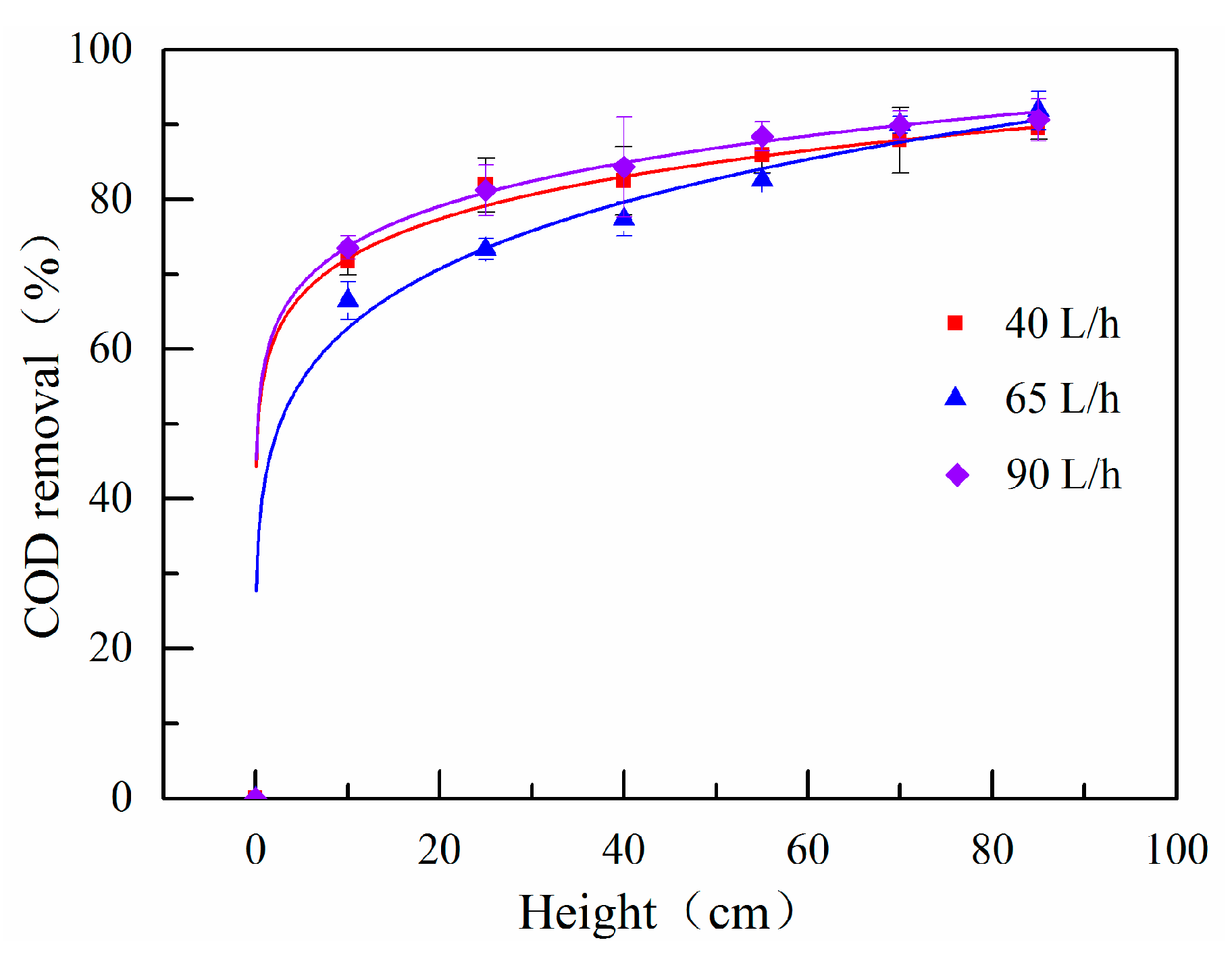
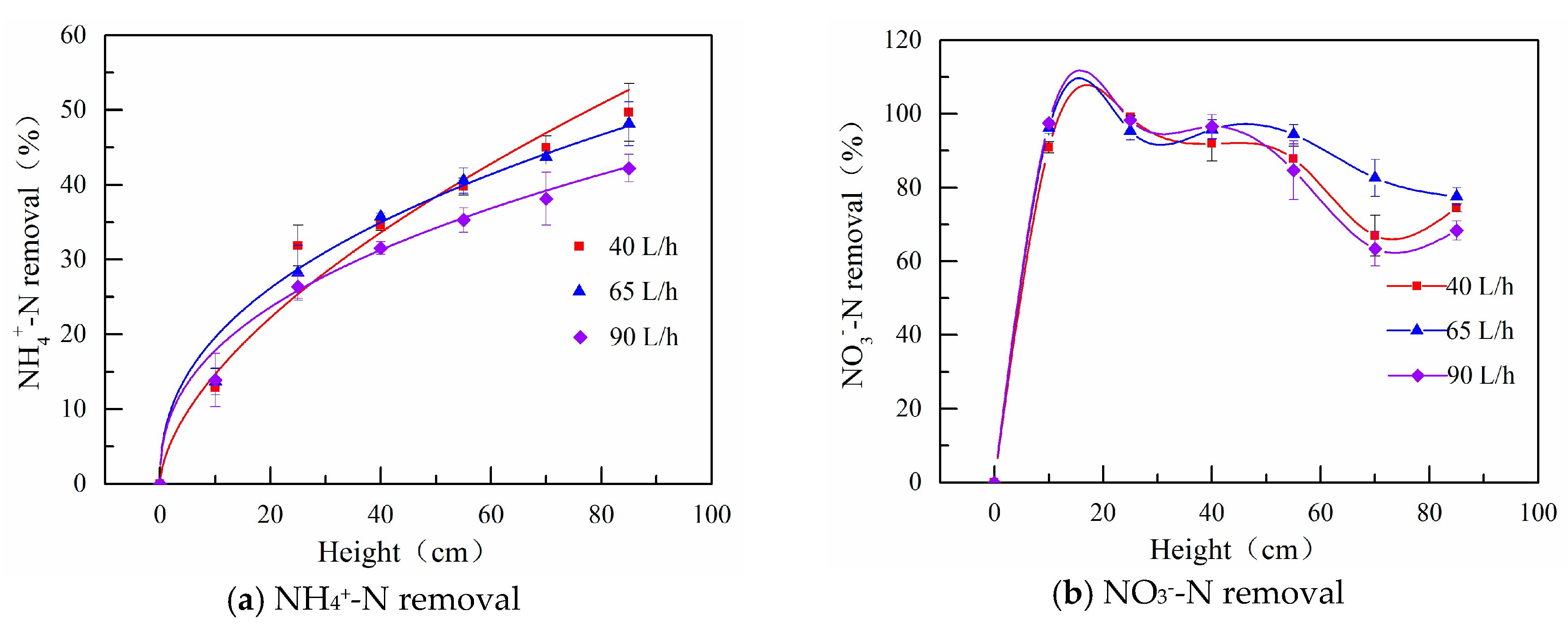
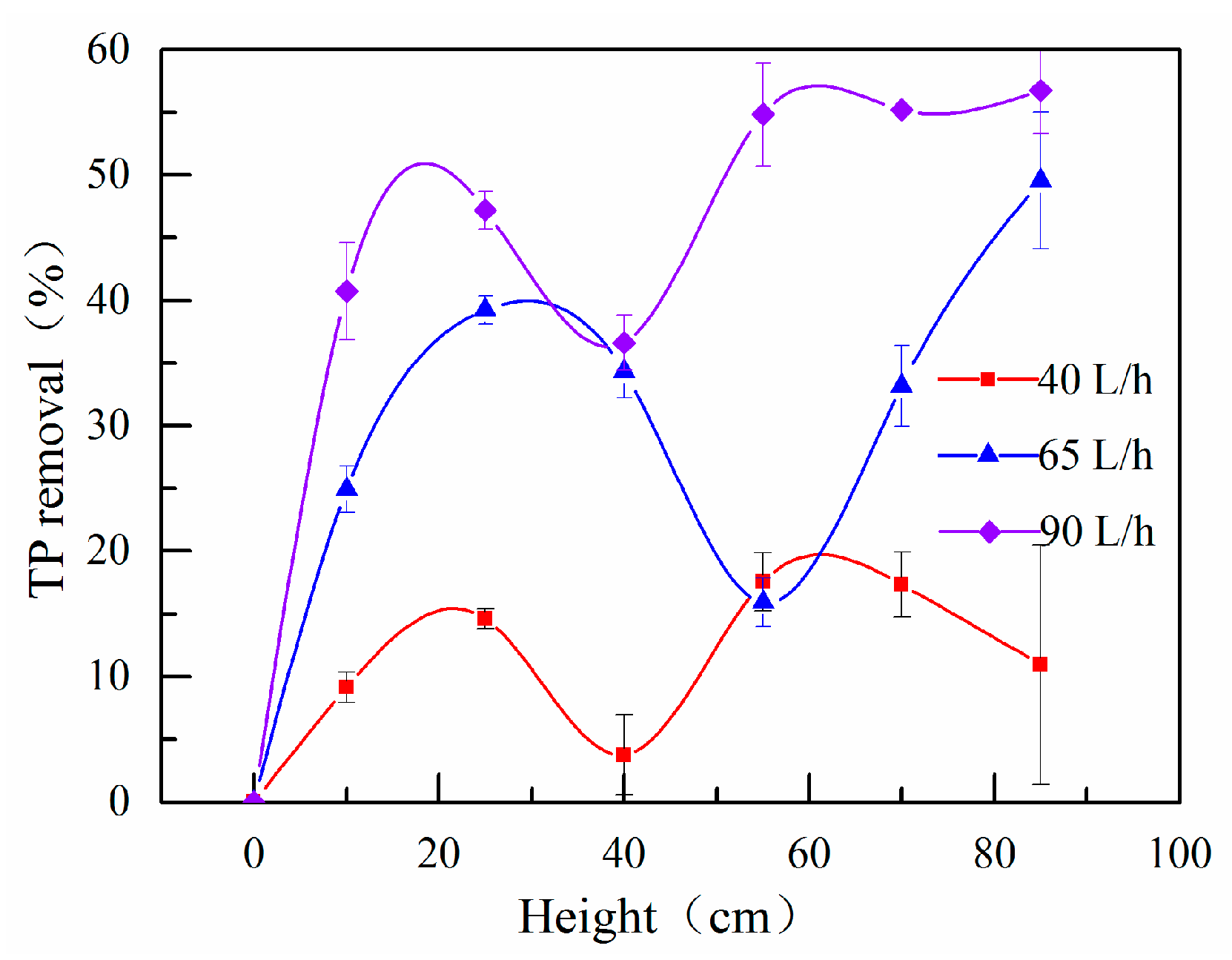
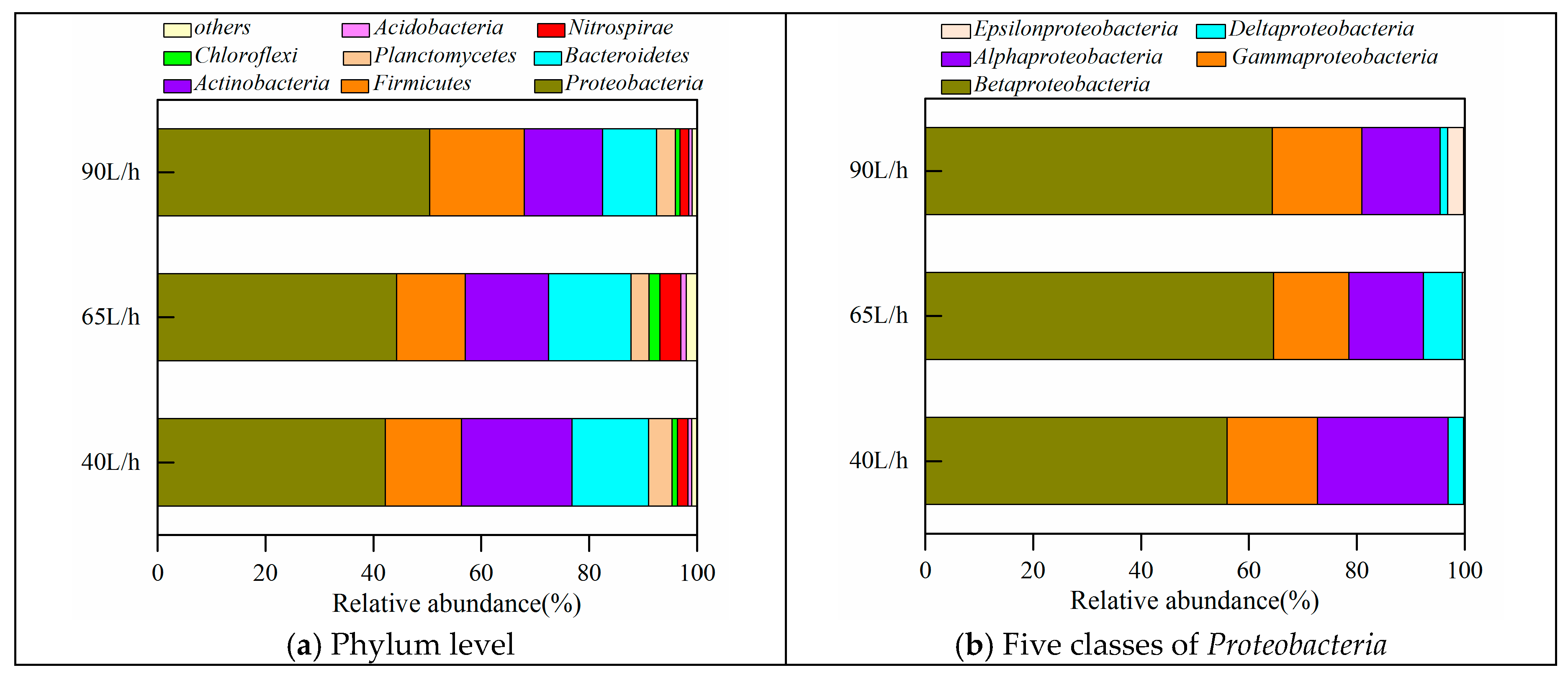
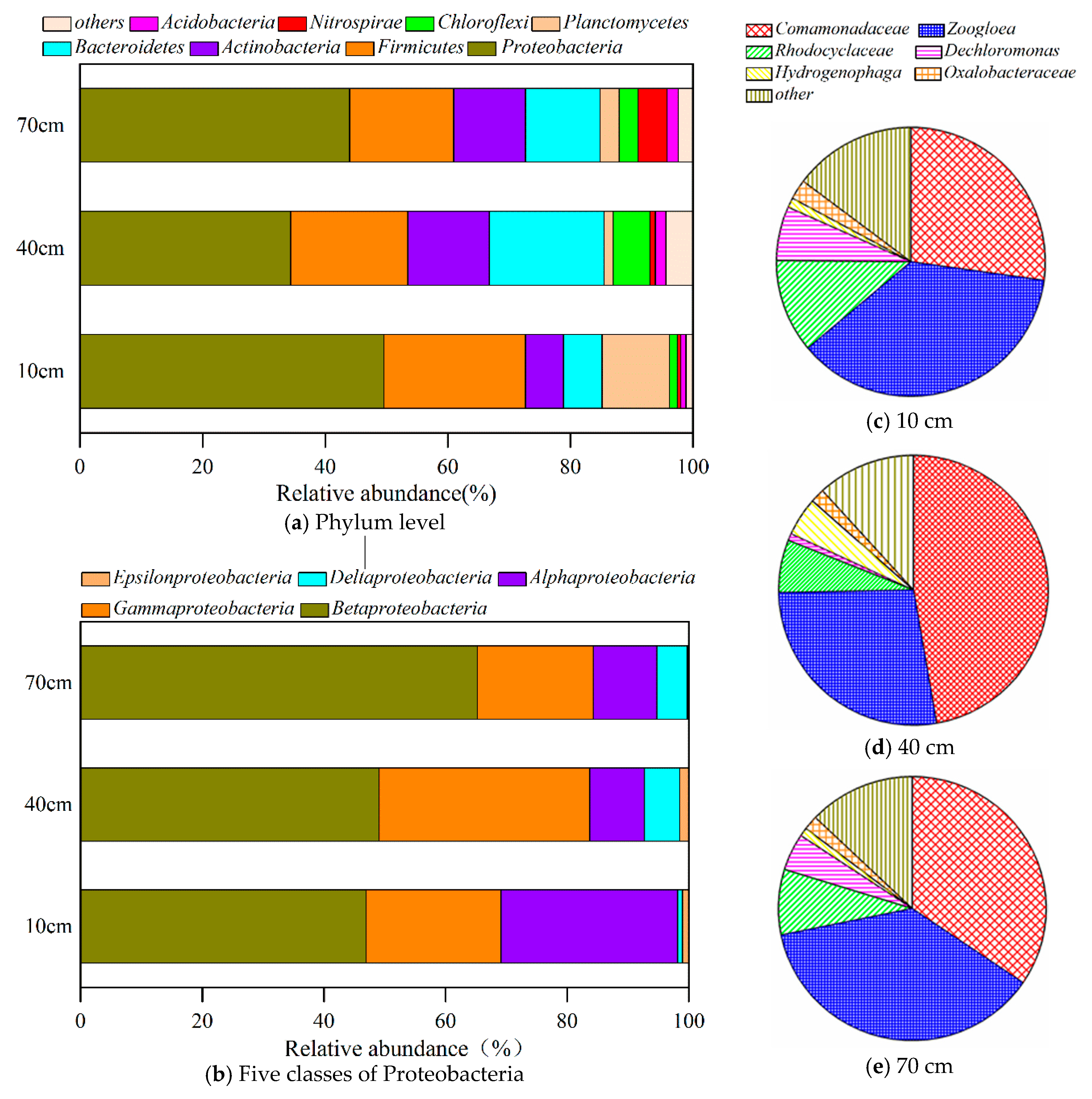
| Aeration Rates | Influent | 10 cm | 25 cm | 40 cm | 55 cm | 70 cm | Effluent |
|---|---|---|---|---|---|---|---|
| 40 L/h | 8.59 | 1.96 | 2.42 | 1.81 | 1.70 | 2.76 | 8.60 |
| 65 L/h | 8.67 | 0.95 | 1.35 | 1.13 | 0.90 | 1.71 | 8.56 |
| 90 L/h | 9.03 | 1.63 | 2.76 | 2.91 | 3.85 | 4.95 | 8.99 |
| Sample | OTUs | Simpson | Chao1 | ACE | Shannon |
|---|---|---|---|---|---|
| 40 L/h | 433 | 0.9819 | 910 | 1340.01 | 6.64 |
| 65 L/h | 430 | 0.9775 | 962 | 1341.49 | 7.21 |
| 90 L/h | 414 | 0.9580 | 895 | 1277.43 | 6.53 |
| 10 cm | 413 | 0.9530 | 943 | 1362.56 | 6.72 |
| 40 cm | 476 | 0.9646 | 825 | 1166.10 | 6.85 |
| 70 cm | 458 | 0.9709 | 1032 | 1417.76 | 7.17 |
© 2018 by the authors. Licensee MDPI, Basel, Switzerland. This article is an open access article distributed under the terms and conditions of the Creative Commons Attribution (CC BY) license (http://creativecommons.org/licenses/by/4.0/).
Share and Cite
Ren, J.; Cheng, W.; Wan, T.; Wang, M.; Zhang, C. Effect of Aeration Rates and Filter Media Heights on the Performance of Pollutant Removal in an Up-Flow Biological Aerated Filter. Water 2018, 10, 1244. https://doi.org/10.3390/w10091244
Ren J, Cheng W, Wan T, Wang M, Zhang C. Effect of Aeration Rates and Filter Media Heights on the Performance of Pollutant Removal in an Up-Flow Biological Aerated Filter. Water. 2018; 10(9):1244. https://doi.org/10.3390/w10091244
Chicago/Turabian StyleRen, Jiehui, Wen Cheng, Tian Wan, Min Wang, and Chengcheng Zhang. 2018. "Effect of Aeration Rates and Filter Media Heights on the Performance of Pollutant Removal in an Up-Flow Biological Aerated Filter" Water 10, no. 9: 1244. https://doi.org/10.3390/w10091244





